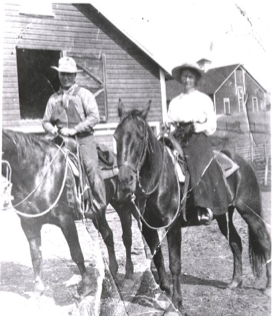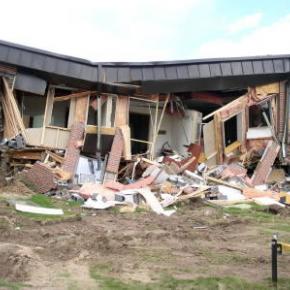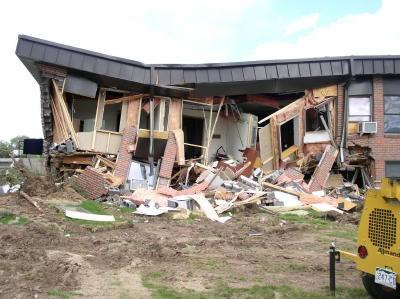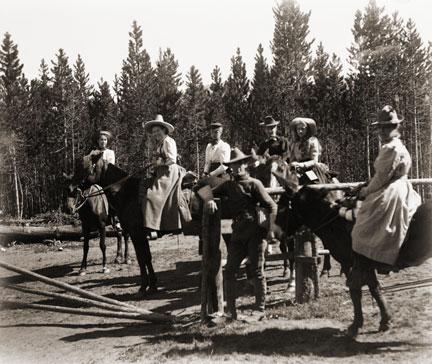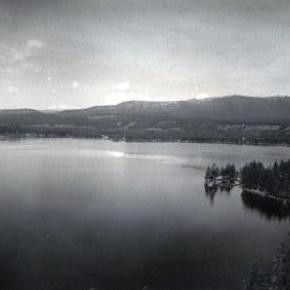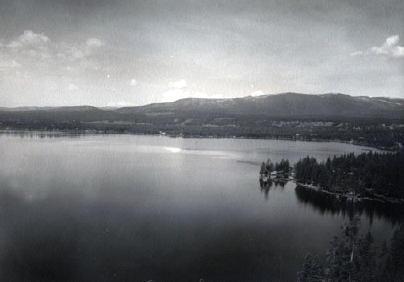Community Life Articles
| Next stop - Kremmling |
Next stop - Kremmling
The rails reached Kremmling town
|
| Ninety Four Winters So Far |
Ninety Four Winters So Far
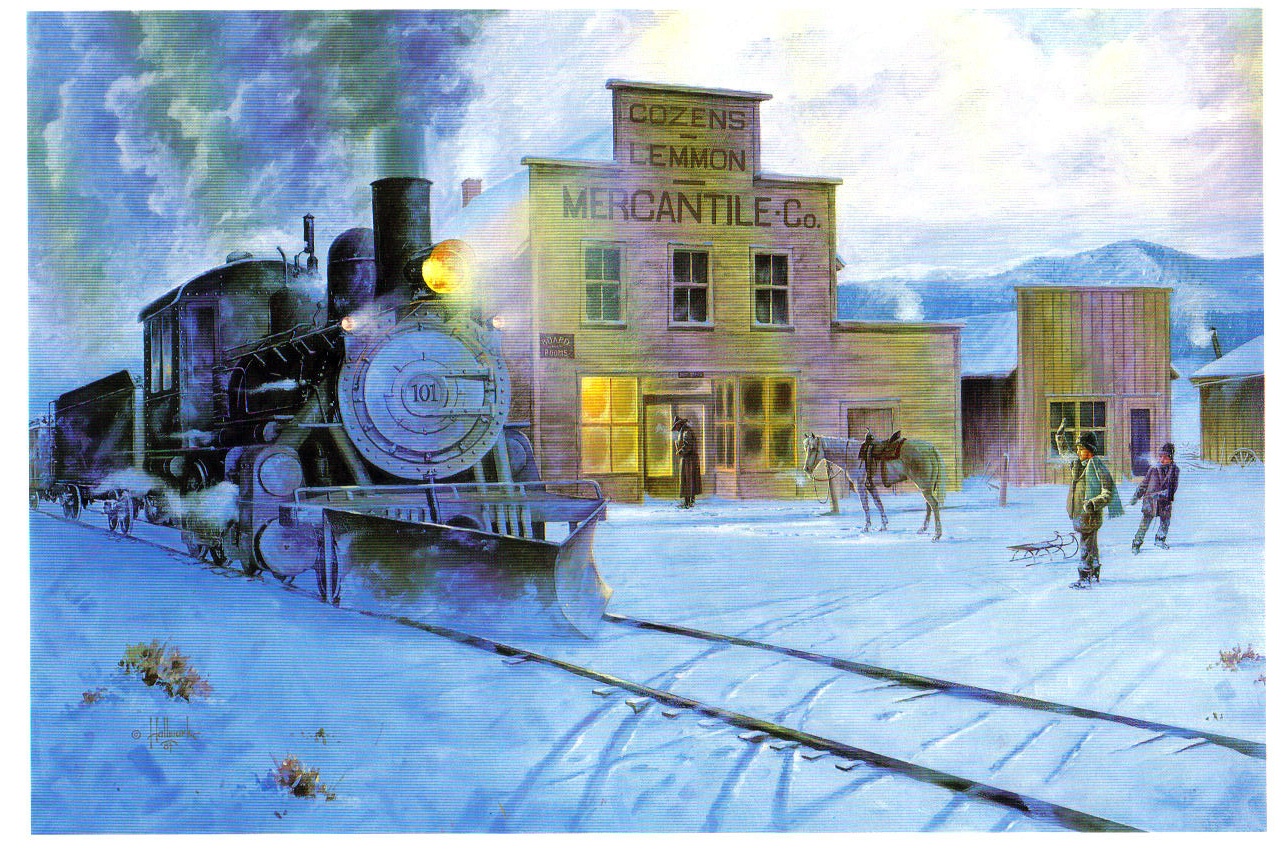
January, 1911. Five years ago they were teenagers in Torsby, Sweden, oblivious to the sweeping changes that history and hope would bring to their lives. Now they’re in a mountain valley halfway around the world from their Scandinavian homeland, marveling at the tiny bundle of flesh and spirit who has just joined their family. It’s the coldest week of the year in one of the coldest spots in America, but there’s a fire crackling in the woodstove, and their hearts are warm with love for each other and their firstborn child. For the next few days, a parade of fellow Swedes stop by to pay their respects to the newest resident of the town of Fraser: Elsie Josephine Goranson. |
| Oh, the Joy of Bicycling! |
Oh, the Joy of Bicycling!
Bicycling has been a favorite pastime in recent years in Grand County. People pedaling along the highway, crowds crawling through the forests the mountains are full of folks getting their exercise. Many of the bicycles are worth thousands of dollars, and have who knows how many gears. People weren’t always so lucky, but the urge to use this form of transportation started early. For instance, back in 1892, see Volume II, 1982, of the GCHA Journal, The Journey, Mr. and Mrs. Hatch had decided to tour this area. That year, Agnes was dared by her husband to hike the total route from Georgetown to Grand Lake. He never thought she could do it, but she did….in four days. The following year, 1893, they determined to ride bikes over the same trail. Mr. Hatch was positive that his wife would be more comfortable in bloomers, so he persuaded her to make some. However, she also took along a full skirt that she could button in a hurry. On the pass, Mrs. Hatch would crouch by her bicycle whenever they met a freighting team. She was really embarrassed to be seen in bloomers. Even at that, horses shied a little. Mr. Hatch urged her just to go on and walk by her bicycle. She tried this, but the horses were so frightened, they nearly ran way. She went ahead and put her skirt on after that! |
| Picnics, Games and Socials |
Picnics, Games and Socials
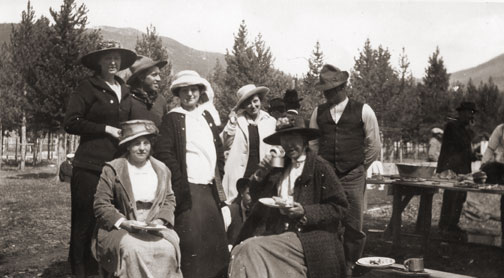
Article contributed by Abbott Fay There were many games and leisure time activities enjoyed by the early settlers in Some of the more athletic pursuits included swimming, which was very popular in the summer and during winter at the Hot Sulphur Springs. Contests of croquet and horseshoes were played at almost all the resorts and dude ranches. Several times, the Middle Park Fair Horseshoe Champion went on to compete at the Colorado State Fair, and in 1920, a local winner went on to the World Championships held in Minnesota. All sorts of tag games were invented, including a version called "Fox and Geese" played in the snow fields of winter. A variation which is rarely seen today was called "Statues". In this game, "it" would whirl each player around and then release him or her. However the released one landed, that position had to be held totally motionless (as a statue). After all the players had been cast off into statues, "it" would pass among them looking for even the slightest motion, even to the blink of an eye. As "it" caught a victim in movement, the victim then had to join "it" to pass among the statues, often taunting and teasing to elicit a movement, until only one statue remained. The final statue became "it" for the next round. Rope jumping, hop scotch, sleigh riding, skiing and ski-jouring have all been mentioned in letters, diaries and newspaper accounts. Potluck picnics were frequent in the summers. Ranch families would meet on Saturday nights in the school house for dancing. At church celebrations there was almost always a cake-walk and donated box lunches were auctioned off. In additional to fishing and hunting, rodeos gradually replaced informal races and other private ranch contests. One of the first rodeos in the nation was held at Deer Trail in As for musical entertainment in those days before phonographs or radios, many people would perform at public and private gatherings. Violinist, often self-taught, would play with other instrumentalists in what were called "hoe downs". Mountain men often carried mouth harps for self-entertainment or impromptu performances for other trappers and Indians. Accordianists were very popular at polka dances and the Jew harp was another common musical instrument. On long lonely treks, some travelers would sing, not only for pleasure, but to scare away predatory animals. Some ladies cultivated excellent singing voices and were often accompanied by piano music. Pianos were more common in homes a century ago than they are today. For households without a capable musician, there were player pianos, which made music from rolls of perforated paper to reproduce popular and classic tunes. Story-telling was an art for some talented individuals, who were the highlight feature at many gatherings. Some stories ended on a humorous note; other were mysterious or even scary. Conversation was also considered a form of entertainment. Women's sewing bees were welcomed for the gossip opportunities as well as the craftsmanship. Essentially, there was much more individual participation and carefully planned intermingling in those days than the more passive entertainment (TV, video games, movies, etc.) of today. Sources: Merlyn Simmonds Mohr, The New Games Treasury, Gertrude Hollingsworth, I Rember Fraser, Fraser, CO Luela Pritchett, Maggie By My Side, Candy Moulton, A Writers Guide to Everyday Life in the Wild West, Robert C. Black, |
| Post Offices |
Post Offices

Article contributed by Abbott Fay Postal routes into Middle Park were first offered for contract to the lowest bidders in 1875. A once a week route over Rollins Pass was bid at $693 per year but winter was so severe that the service stopped. The route from Georgetown to Hot Sulphur Springs over Berthoud Pass from July through October was more enduring. Later, postmaster appointments were recommended by congressmen, thereby making the the system more variable as political party power shifted at election time. The great advantage to having a post office was the opportunity to include a retail goods for sale, often in the living room of the postmaster's home. Post offices were located within 10 miles of the addresses they served. In those days, a 10 mile round trip would often take a full day of travel by horse or wagon. Many post offices were simply ranch homes, and there were frequent changes in location due to disabilities or political party changes. Post offices were closed when there were too few recipients to justify the cost, often caused by consolidation of ranches or mine closures. As transportation became mechanized, there was no longer the need for a 10 mile radius maximum.
Hot Fraser July 20, 1876 William Z. Cozens Troublesome (When Henry King died in 1879, his wife Albina replaced him. The Troublesome office was discontinued on April 19, 1935) (Discontinued in September 1878) Hermitage (Intermittent service. Discontinued Jan. 10, 1884)
Twelve Mile June 1879 Daniel N. Ostrander (Discontinued Aug. 5, 1880)
(Discontinued Nov. 26, 1883)
Gaskill (Discontinued Nov. 11, 1886) Colorow (Discontinued May 16, 1903) Selak (Discontinued Sept. 29, 1893)
(Discontinued July 9, 1885) Coulter (Discontinued Sept. 20, 1905)
Kremmling Kinsey
Crescent (Discontinued April 16, 1894) Clarkson (Discontinued Dec. 8, 1898)
Dexter (Discontinued May 20, 1911) Martin Discontinued Nov. 3, 1934)
Scholl (Discontinued Jan. 21, 1930)
Lohman (Name changed to Stillwater on Oct. 4, 1911. Discontinued Oct. 29, 1930) Leal (Discontinued April 30, 1930) Arrow (Discontinued March 15, 1915) Tabernash Sept. 30. 1905 Mary Knight Radium (Discontinued Dec. 6, 1963)
Parshall < |
| Prisoners of War |
Prisoners of War

Article contributed by Abbott Fay German Prisoner of War camps existed in Fraser and Kremmling during the wartime years of 1945-1946 The Fraser camp provided much needed labor for lumber production while the Kremmling camp shipped cut ice by rail, mostly to the Grand Junction area. In Fraser, some 200 prisoners loaded an average of 25,000 feet of lumber on rail cars every day. They were quick learners; doing all phases of the work, from horseshoeing to bookkeeping. For their hard work, they were paid 75 cents a day, which they could spend at their Post Exchange. The prisoners in the Fraser area were were sometimes rewarded with trips to the local movie theater. They were also allowed to form a dance band utilizing homemade instruments and were permitted to bake special German pastries. Examples of the beautiful inlay woodworking skills of the prisoners are on display at the Grand County Museum in Hot Sulphur Springs. Source: |
| Railroads Build the Ski Industry |
Railroads Build the Ski Industry
In the early to mid-1900s, the popularity of skiing spread across the western United States. Ski areas popped up in many mountain communities, particularly in the Colorado Rockies. Much of this was due to access afforded by the existence of railroads to these areas. Railroads broke the barriers of isolation during the winter months when most other forms of transportation were blocked (skiing being the exception). Grand County has long depended on tourism. From its earliest days of settlement, tourists were drawn to the springs of Hot Sulphur Springs and to the waters of Grand Lake and its surrounding streams. Grand County was reached by stagecoach from Georgetown, via the Berthoud Pass Wagon Road. In the summer months tourists would fill up Hot Sulphur Springs’ five hotels. Nonetheless, those same hotels would sit mostly vacant during the long winter months when the road was shutdown.
In 1911, Hot Sulphur Springs held the first winter sports carnival west of the Mississippi River. The purpose of the carnival was to boost the town’s economy by filling the empty hotels and restaurants with out of town guests for that one weekend at the end of December. This was only possible due to the Moffat Road railroad, which had broken the town’s isolation just six years prior.
Not only did the railroad bring spectators for the winter carnival, it also brought the two most important participants of the event. At least, it brought them part way. Carl Howelsen and Angell Schmidt boarded the train in Denver’s Moffat Station and rode it to the top of the divide at Corona, where they detrained and skied the rest of the 40-plus miles to Hot Sulphur Springs, where the carnival was under way. Once re-united with their fellow train passengers, Howelsen and Schmidt performed the biggest event of the day, the ski jump competition, which made history. The ski jump competition at the 1911 Hot Sulphur Springs Winter Sports Carnival was the first west of the Mississippi and is considered the beginning of Colorado’s ski industry.
The 1911 winter carnival was such a successful and enjoyable event that it grabbed the attention of Denver newspapers on the front pages. Consequently, John Peyer and the other carnival organizers of the carnival decided to make it an annual event and put together the 1st Annual Hot Sulphur Springs Winter Sports Carnival six weeks later in February 1912. The railroad was the sole reason that the success of the winter carnival at Hot Sulphur Springs was even a possibility in those early years. Berthoud Pass, the former wagon road converted to an auto route was closed in the winter months. Even if the highway were open, automobiles of that day could not have made the winter drive anyway. The railroad was the only way to bring people to the remote town in the winter and take advantage of the abundantly snowy hills.
The Moffat Road quickly realized the potential for profit that the Hot Sulphur Springs Winter Carnival presented in the typically slow winter months of the railroad. In 1913, the Denver and Salt Lake Railway (D&SLR) advertised a special round trip fare to Hot Sulphur for the winter carnival. The following year, further up the Moffat Road, Steamboat Springs held its first winter carnival.. Once again, the D&SLR provided the means to reach the new ski destination. People road the rails from Denver and Hot Sulphur Springs.
As the popularity of Hot Sulphur Springs as a winter destination grew, so did ridership of the D&SLR to the winter carnival. In 1936, the Rocky Mountain News sponsored the “Snow Train” to Hot Sulphur Springs for the 25th anniversary of the winter carnival. Despite the fact that Berthoud Pass was open year round starting in 1933, over 2,200 passengers rode the ironhorse from Denver and another 500 came over the Moffat Road from Steamboat Springs for the event. Over 7,000 people attended the carnival that weekend.
In the early years of the ski industry, Nordic was the dominant form of skiing. By the late 1920s, Alpine skiing began to grow by leaps and bounds in the United States. This coincided with the opening of the Moffat Tunnel, which made the railroad far more reliable in the winter time. It would be at the west portal (West Portal) that the railroad would make its biggest impact on skiing in Colorado. Following the opening of the Moffat Tunnel, skiers would ride up to West Portal from Denver to slide the deep and steep slopes immediately adjacent of the tunnel. Not long after the opening of the tunnel, the Arlberg Club was formed and they built their clubhouse not for from the tunnel to take advantage of the rails from Denver to the slopes on the west side of the divide.
Arlberg Club members and other ski enthusiasts flocked to West Portal by rail throughout the 1930s, even though there was no formal ski area. Skiing and riding the train to West Portal was so popular that in 1938 the D&SLR started the “Snow Train,” offering regular weekend service to West Portal. The D&SLR even provided a place for skiers to wax their skis in the West Portal Depot.
The start of the Snow Train coincided with decision of Denver Parks Director, George Cranmer’s decision to locate Denver’s Winter Park at West Portal. Cranmer announced his intention of creating for Denver a winter sports playground that would be “unequalled in the world. When he determined that West Portal would be the location for Denver’s Winter Park he referenced the great ski conditions of the area and additionally remarked that “West Portal may be reached by auto or train.” Cranmer clearly recognized the importance of access by train from Denver.
As ski trails were cut and T-bars were installed on the mountainside the base area facilities for Winter Park were literally constructed on the tailings of the Moffat Tunnel. This provided easy access to the facilities and slopes of the ambitious new ski area for those riding the train from Denver. The D&SLR continued to provide the Snow Train weekend service when Winter Park opened in 1940 for $1.75 per round trip. Unfortunately, due to the demands of World War II and a coal workers strike in 1943, the Snow Train service came to an end. This would prove to be temporary though. In 1946, one year after the end of World War II, the Denver and Rio Grande Western (D&RGW) brought the special weekend service back to Winter Park and christened it as the “Ski Train.” This was the foundation of the Ski Train that ran between Denver and Winter Park until 2009.
Grand County was not the only ski destination that benefitted from the railroads in the early growth years of the ski industry in the west. A couple of major examples are Marshall Pass in Colorado and Sun Valley, Idaho. Beginning in 1938, the D&RGW literally acted as a chairlift for skiers from Salida and Gunnison. A special excursion train on the weekends selling seats as lift tickets to the top of Marshall Pass. The first train sold out with 500 tickets and 200 skiers were turned away that day. The railroad even provided a warming hut at the bottom of the slopes.
In possibly the greatest example of the railroad on the ski industry of the west is Sun Valley, Idaho and the Union Pacific Railroad (UP). Sun Valley was literally the conceived, constructed, and operated by the UP. Under the leadership of Averill Harriman, who was a ski enthusiast himself, conjured up the plan to build a world class ski destination that would rival any in Europe. This resort was to be reached by rail as a means to boost ridership on the UP, which it did. Sun Valley became the glamorous playground for the rich and famous. At Sun Valley, skiing was elevated in class and viewed as elite. Nonetheless, it was at Sun Valley that the railroad made its most significant contribution to the ski industry. The first chairlifts in the world were installed at Sun Valley in 1936, replacing the rope tow. Engineers for the UP developed the chairlift at the railroad’s headquarters in Omaha. The invention of the chairlift transformed the method of how skiers were to be transported to the top of ski trails the world over.
The impact of the railroads on the development of the ski industry in the western United States cannot be understated. Without the assistance of the network of steel that penetrated into remote mountain locations, the ski industry could not have developed with the rapidity that it did in the early part of the 20th century. Furthermore, as we look to the future of the ski industry and try and figure out ways to conveniently transport skiers to the slopes of Colorado trains emerge more and more as the answer. This is apparent in the rejoice that devotees to Winter Park sang when Amtrak’s Winter Park Express returned weekend service in 2017 that had been left in a void ever since the Ski Train made its last run in 2009. Once again skiers are riding the rails of the old Moffat Road.
|
| Religion |
Religion

Article contributed by Betty Jo Woods The first known white settlers came to Grand County about 1874 but there were no established churches for many years. The area even lacked circuit riders and camp meetings so typical of many other parts of the West. The first building used exclusively for a church was probably an Episcopal church in Grand Lake, erected in 1896, but used sporadically during summers only. An Arapahoe Indian who was an Episcopal priest held occasional services in that town. The First Congregational Church of Hot Sulphur Springs was dedicated in 1904 and other churches were also established about the same time in Kremmling and Fraser. Sunday School activities along with special holiday services and women’s activities seemed to be what provided continuity to worship efforts. Curiously, at one time a local newspaper carried weekly Sunday School lessons. A Greek Orthodox church was built in Hot Sulphur Springs for the many of that faith who visit there. A major growth spurt developed during the last quarter of the 1900’s when older buildings became overcrowded and residents, long-term and recent, decided to commit time and money to new church buildings. In 2004, 28 churches were listed in the telephone directory. |
| Schools |
Schools

Article contributed by Betty Jo Woods The first official school in Grand County was founded in 1875 in Hot Sulphur Springs in a crude dugout. The school met for twenty days and a painting of the classroom shows nine students in attendance. Typically the woman teachers of that era would have earned about $25 per month. In the 1890s school was not held every year in Grand Lake because not enough taxes were raised to pay for a teacher. The school year was generally April through October and classes were held in various vacant buildings for many years. The first schoolhouse in Grand Lake was built in 1910 and remained a one-teacher school until 1935. A notice published in the Middle Park Times on january 31, 1889 annouce that a masquerade ball and supper of "beef steer and chickens" would be held on February 14th to raise money to build a school. |
| Sir Edmund Hillary visits Grand County |
Sir Edmund Hillary visits Grand County
The Middle Park Times announced with excitement: Sir Edmund Hillary is going to visit Grand County! The paper reviewed his famous climb up Everest in 1953 at age 33, his New Zealand background, his other well-known exploits; his picture was highlighted on the page with his story. This was news of great interest to the area citizens, for there was little in the way of unusual happenings as a rule. Dwight Miller had wandered down to the Hideaway Park Post Office one summer afternoon, when a man, asking for information, stopped him. "Can you tell me where the Tabernash Campground is?" Dwight took one look at him and recognized the long, somewhat horsey-looking face. The chap's accent sounded British to Dwight, too. "Are you Sir Edmund Hillary," he asked? "Why yes, I am," answered Sir Edmund. "We're traveling through this area and want to spend the night." For a moment Dwight considered asking him and his party to stay at Miller's Idlewild Inn that night, but he thought probably the group really preferred being alone to enjoy the countryside, rather than having to deal with crowds. He was aware that the climber was a very shy, modest man. So he told Hillary to drive about six miles on down Highway 40, through Fraser and Tabernash; then follow the road to the top of Red Dirt Hill. The campground he wanted was on the right side of the road, just before it descended toward Granby. Close by, on the left side of the highway, Hillary would see a large meadow, in which were dairy cows, belonging to the Acord Dairy, I believe. "The campground is set among the pines with just a few camp sites, so you shouldn't be disturbed," Dwight said. Sir Edmund thanked Dwight and the two of them chatted a bit more. "We just came over Berthoud Pass a bit ago; in fact we ate lunch there. Something that really puzzles me is that I see you Americans just eating lunch while sitting in your cars or on your tailgates; and yet, if you were to take your lunch and walk about 100 feet, you would have all the valleys before you and never know that you that you were even near another person!" "That's true," said Dwight. "I think that Americans are always in a hurry. They don't want to take time to walk a few feet. It's just eat and run." "Well, it amazes me. You live in such beautiful country." They said goodbye then and the Hillarys drove on down to the campground. Dwight was so very pleased to have had this chance to meet him. This campground was shut down some years later when the U.S. Forest Service traded that land to the Silver Creek group for some other property, so that Silver Creek could have a convenient road into their development. The campground was located just beyond the turn in to Snow Mountain Ranch, as one heads west. A few site remnants can still be seen there. |
- ‹ previous
- 5 of 7
- next ›









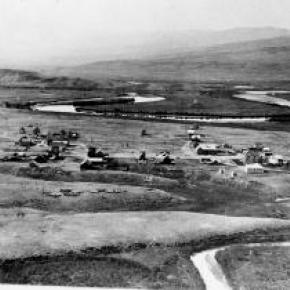
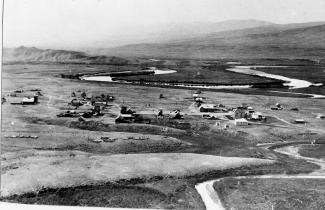
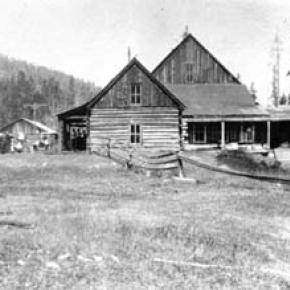
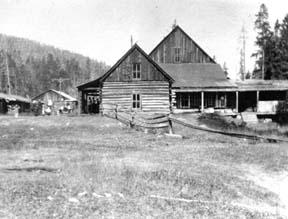
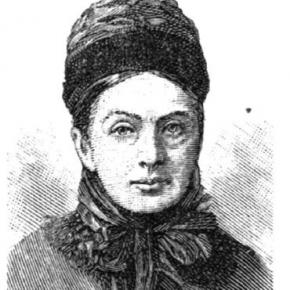
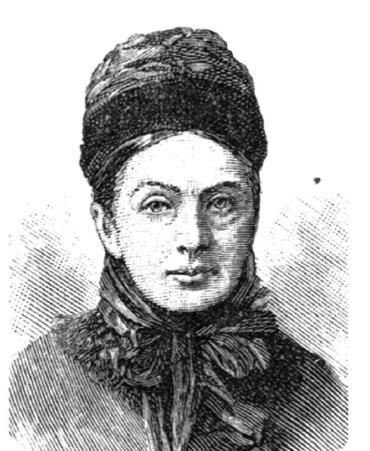
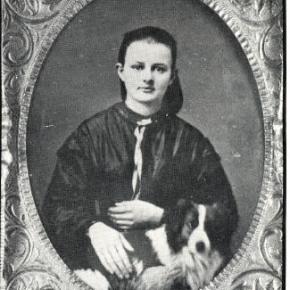
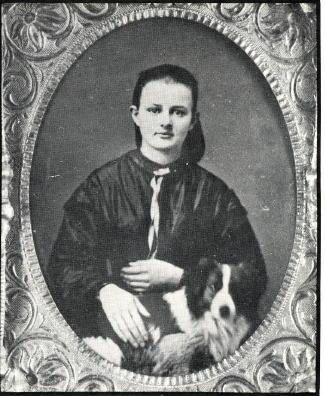
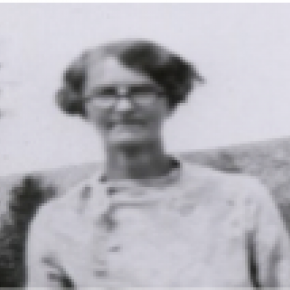
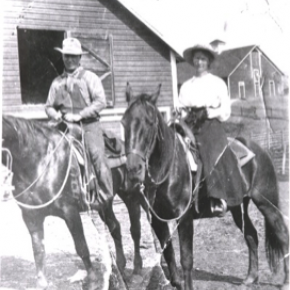
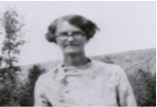 ,
, 